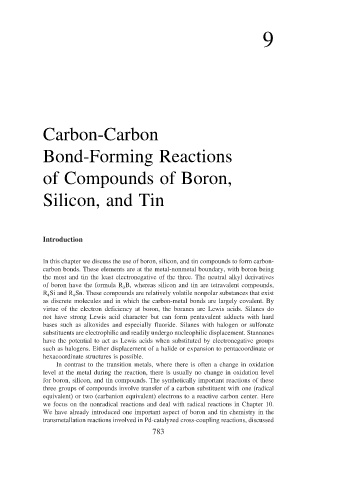Page 807 - Advanced Organic Chemistry Part B - Reactions & Synthesis
P. 807
9
Carbon-Carbon
Bond-Forming Reactions
of Compounds of Boron,
Silicon, and Tin
Introduction
In this chapter we discuss the use of boron, silicon, and tin compounds to form carbon-
carbon bonds. These elements are at the metal-nonmetal boundary, with boron being
the most and tin the least electronegative of the three. The neutral alkyl derivatives
of boron have the formula R B, whereas silicon and tin are tetravalent compounds,
3
R Si and R Sn. These compounds are relatively volatile nonpolar substances that exist
4
4
as discrete molecules and in which the carbon-metal bonds are largely covalent. By
virtue of the electron deficiency at boron, the boranes are Lewis acids. Silanes do
not have strong Lewis acid character but can form pentavalent adducts with hard
bases such as alkoxides and especially fluoride. Silanes with halogen or sulfonate
substituents are electrophilic and readily undergo nucleophilic displacement. Stannanes
have the potential to act as Lewis acids when substituted by electronegative groups
such as halogens. Either displacement of a halide or expansion to pentacoordinate or
hexacoordinate structures is possible.
In contrast to the transition metals, where there is often a change in oxidation
level at the metal during the reaction, there is usually no change in oxidation level
for boron, silicon, and tin compounds. The synthetically important reactions of these
three groups of compounds involve transfer of a carbon substituent with one (radical
equivalent) or two (carbanion equivalent) electrons to a reactive carbon center. Here
we focus on the nonradical reactions and deal with radical reactions in Chapter 10.
We have already introduced one important aspect of boron and tin chemistry in the
transmetallation reactions involved in Pd-catalyzed cross-coupling reactions, discussed
783

